Report: The Aegis System Development Using Agile DSDM Methodology
VerifiedAdded on 2023/05/27
|30
|6268
|69
Report
AI Summary
This report details the development of the Aegis system, a disaster management system, using the Agile DSDM (Dynamic Systems Development Method) approach. It begins with a critical explanation of the rationale for choosing DSDM, highlighting its strengths such as time and budget efficiency, ease of use, and user involvement, while also acknowledging its limitations. The report then describes the stakeholders involved, including the Lazarus Island Government, Government Agency Administrators, NGO Administrators, and NGO Workers, along with their respective roles. It delves into the MoSCoW technique for prioritizing requirements, user stories, and the use of prototypes for iterative development. The report further elaborates on the iterative development process, including time-box planning and handling user-requested changes. Finally, it includes a first-cut class diagram to visualize the system's architecture and functionality. The report emphasizes the importance of user involvement and the adaptability of the DSDM approach in managing complex projects with evolving requirements.
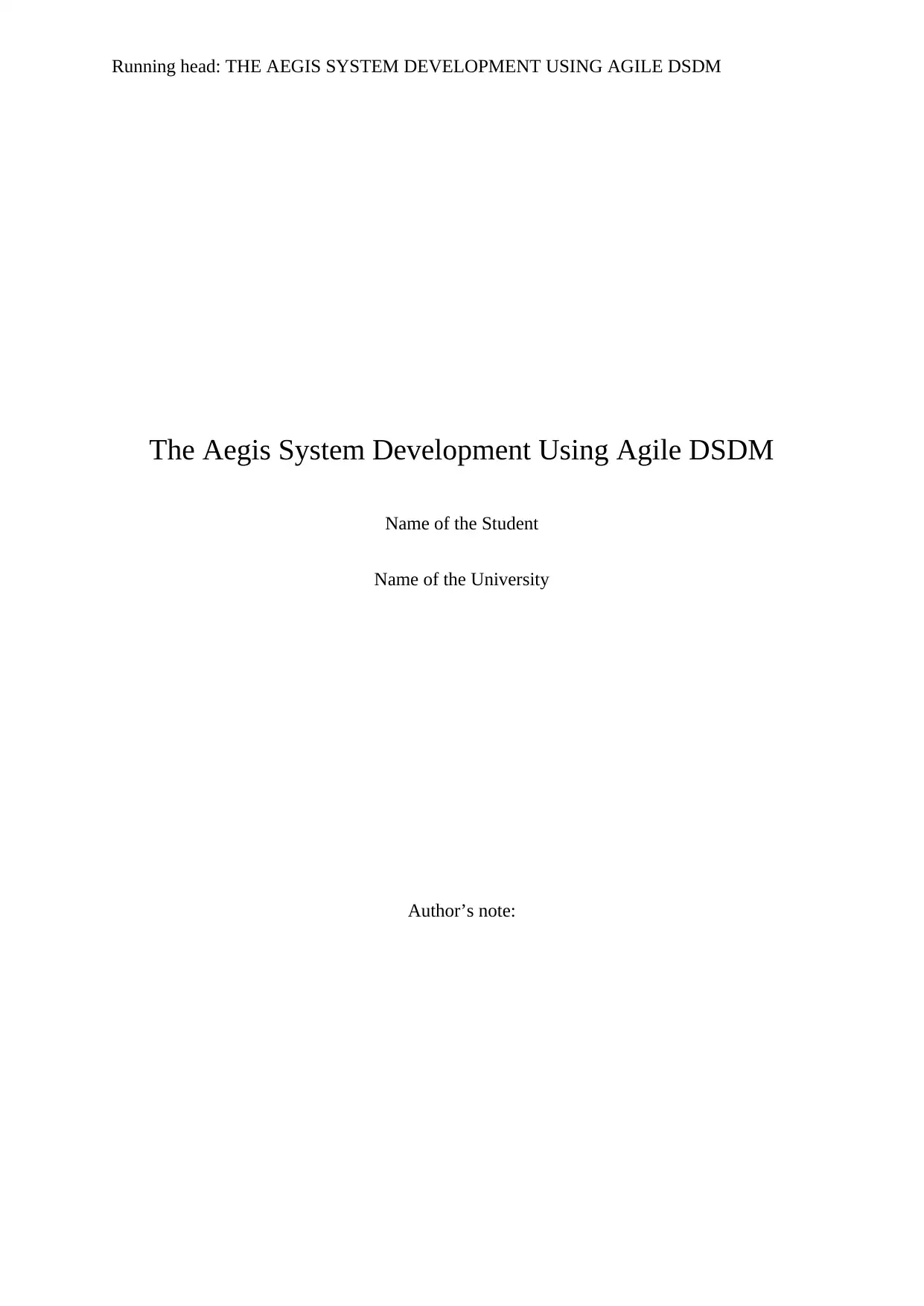
Running head: THE AEGIS SYSTEM DEVELOPMENT USING AGILE DSDM
The Aegis System Development Using Agile DSDM
Name of the Student
Name of the University
Author’s note:
The Aegis System Development Using Agile DSDM
Name of the Student
Name of the University
Author’s note:
Paraphrase This Document
Need a fresh take? Get an instant paraphrase of this document with our AI Paraphraser
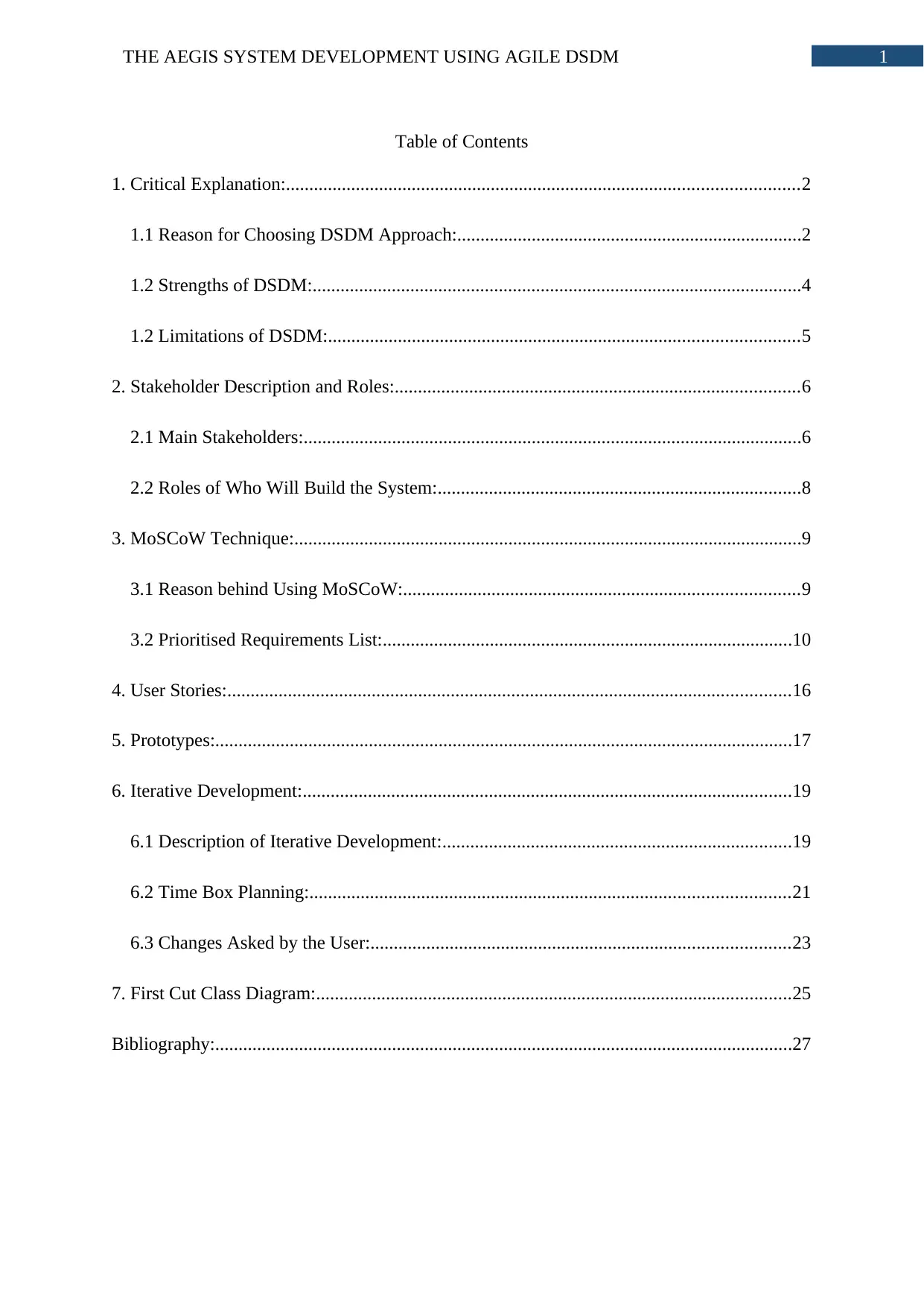
1THE AEGIS SYSTEM DEVELOPMENT USING AGILE DSDM
Table of Contents
1. Critical Explanation:..............................................................................................................2
1.1 Reason for Choosing DSDM Approach:..........................................................................2
1.2 Strengths of DSDM:.........................................................................................................4
1.2 Limitations of DSDM:.....................................................................................................5
2. Stakeholder Description and Roles:.......................................................................................6
2.1 Main Stakeholders:...........................................................................................................6
2.2 Roles of Who Will Build the System:..............................................................................8
3. MoSCoW Technique:.............................................................................................................9
3.1 Reason behind Using MoSCoW:.....................................................................................9
3.2 Prioritised Requirements List:........................................................................................10
4. User Stories:.........................................................................................................................16
5. Prototypes:............................................................................................................................17
6. Iterative Development:.........................................................................................................19
6.1 Description of Iterative Development:...........................................................................19
6.2 Time Box Planning:.......................................................................................................21
6.3 Changes Asked by the User:..........................................................................................23
7. First Cut Class Diagram:......................................................................................................25
Bibliography:............................................................................................................................27
Table of Contents
1. Critical Explanation:..............................................................................................................2
1.1 Reason for Choosing DSDM Approach:..........................................................................2
1.2 Strengths of DSDM:.........................................................................................................4
1.2 Limitations of DSDM:.....................................................................................................5
2. Stakeholder Description and Roles:.......................................................................................6
2.1 Main Stakeholders:...........................................................................................................6
2.2 Roles of Who Will Build the System:..............................................................................8
3. MoSCoW Technique:.............................................................................................................9
3.1 Reason behind Using MoSCoW:.....................................................................................9
3.2 Prioritised Requirements List:........................................................................................10
4. User Stories:.........................................................................................................................16
5. Prototypes:............................................................................................................................17
6. Iterative Development:.........................................................................................................19
6.1 Description of Iterative Development:...........................................................................19
6.2 Time Box Planning:.......................................................................................................21
6.3 Changes Asked by the User:..........................................................................................23
7. First Cut Class Diagram:......................................................................................................25
Bibliography:............................................................................................................................27
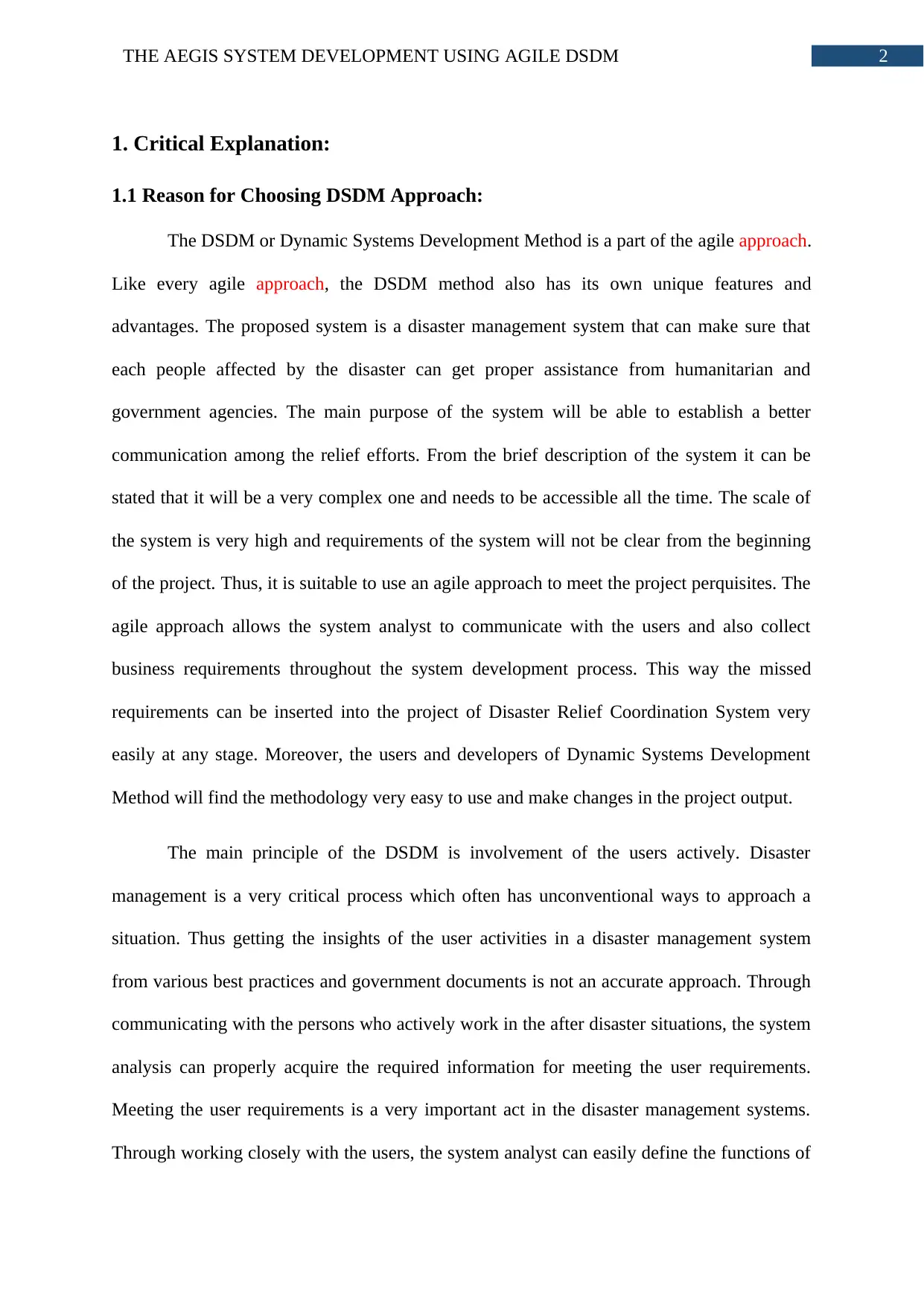
2THE AEGIS SYSTEM DEVELOPMENT USING AGILE DSDM
1. Critical Explanation:
1.1 Reason for Choosing DSDM Approach:
The DSDM or Dynamic Systems Development Method is a part of the agile approach.
Like every agile approach, the DSDM method also has its own unique features and
advantages. The proposed system is a disaster management system that can make sure that
each people affected by the disaster can get proper assistance from humanitarian and
government agencies. The main purpose of the system will be able to establish a better
communication among the relief efforts. From the brief description of the system it can be
stated that it will be a very complex one and needs to be accessible all the time. The scale of
the system is very high and requirements of the system will not be clear from the beginning
of the project. Thus, it is suitable to use an agile approach to meet the project perquisites. The
agile approach allows the system analyst to communicate with the users and also collect
business requirements throughout the system development process. This way the missed
requirements can be inserted into the project of Disaster Relief Coordination System very
easily at any stage. Moreover, the users and developers of Dynamic Systems Development
Method will find the methodology very easy to use and make changes in the project output.
The main principle of the DSDM is involvement of the users actively. Disaster
management is a very critical process which often has unconventional ways to approach a
situation. Thus getting the insights of the user activities in a disaster management system
from various best practices and government documents is not an accurate approach. Through
communicating with the persons who actively work in the after disaster situations, the system
analysis can properly acquire the required information for meeting the user requirements.
Meeting the user requirements is a very important act in the disaster management systems.
Through working closely with the users, the system analyst can easily define the functions of
1. Critical Explanation:
1.1 Reason for Choosing DSDM Approach:
The DSDM or Dynamic Systems Development Method is a part of the agile approach.
Like every agile approach, the DSDM method also has its own unique features and
advantages. The proposed system is a disaster management system that can make sure that
each people affected by the disaster can get proper assistance from humanitarian and
government agencies. The main purpose of the system will be able to establish a better
communication among the relief efforts. From the brief description of the system it can be
stated that it will be a very complex one and needs to be accessible all the time. The scale of
the system is very high and requirements of the system will not be clear from the beginning
of the project. Thus, it is suitable to use an agile approach to meet the project perquisites. The
agile approach allows the system analyst to communicate with the users and also collect
business requirements throughout the system development process. This way the missed
requirements can be inserted into the project of Disaster Relief Coordination System very
easily at any stage. Moreover, the users and developers of Dynamic Systems Development
Method will find the methodology very easy to use and make changes in the project output.
The main principle of the DSDM is involvement of the users actively. Disaster
management is a very critical process which often has unconventional ways to approach a
situation. Thus getting the insights of the user activities in a disaster management system
from various best practices and government documents is not an accurate approach. Through
communicating with the persons who actively work in the after disaster situations, the system
analysis can properly acquire the required information for meeting the user requirements.
Meeting the user requirements is a very important act in the disaster management systems.
Through working closely with the users, the system analyst can easily define the functions of
⊘ This is a preview!⊘
Do you want full access?
Subscribe today to unlock all pages.

Trusted by 1+ million students worldwide
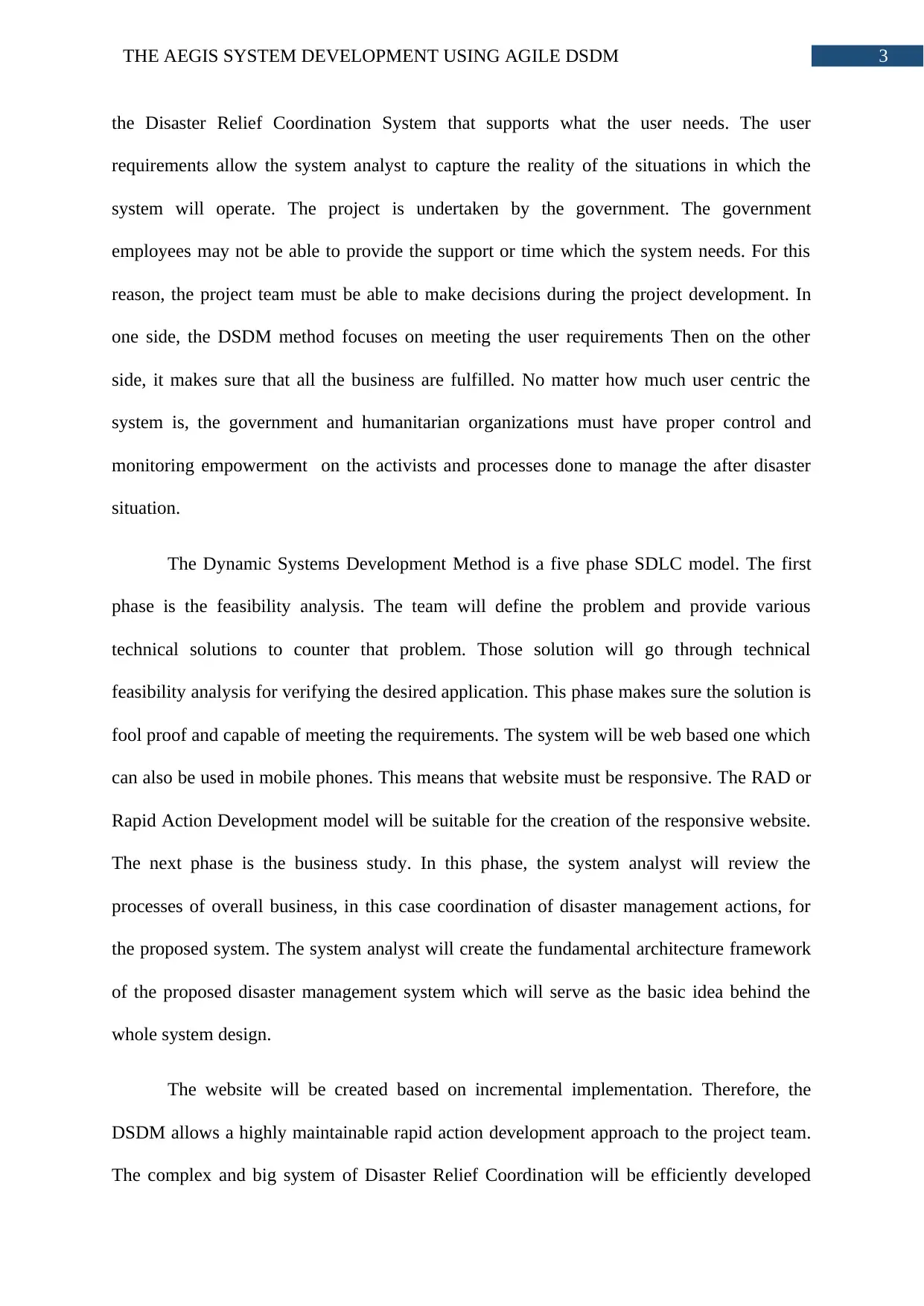
3THE AEGIS SYSTEM DEVELOPMENT USING AGILE DSDM
the Disaster Relief Coordination System that supports what the user needs. The user
requirements allow the system analyst to capture the reality of the situations in which the
system will operate. The project is undertaken by the government. The government
employees may not be able to provide the support or time which the system needs. For this
reason, the project team must be able to make decisions during the project development. In
one side, the DSDM method focuses on meeting the user requirements Then on the other
side, it makes sure that all the business are fulfilled. No matter how much user centric the
system is, the government and humanitarian organizations must have proper control and
monitoring empowerment on the activists and processes done to manage the after disaster
situation.
The Dynamic Systems Development Method is a five phase SDLC model. The first
phase is the feasibility analysis. The team will define the problem and provide various
technical solutions to counter that problem. Those solution will go through technical
feasibility analysis for verifying the desired application. This phase makes sure the solution is
fool proof and capable of meeting the requirements. The system will be web based one which
can also be used in mobile phones. This means that website must be responsive. The RAD or
Rapid Action Development model will be suitable for the creation of the responsive website.
The next phase is the business study. In this phase, the system analyst will review the
processes of overall business, in this case coordination of disaster management actions, for
the proposed system. The system analyst will create the fundamental architecture framework
of the proposed disaster management system which will serve as the basic idea behind the
whole system design.
The website will be created based on incremental implementation. Therefore, the
DSDM allows a highly maintainable rapid action development approach to the project team.
The complex and big system of Disaster Relief Coordination will be efficiently developed
the Disaster Relief Coordination System that supports what the user needs. The user
requirements allow the system analyst to capture the reality of the situations in which the
system will operate. The project is undertaken by the government. The government
employees may not be able to provide the support or time which the system needs. For this
reason, the project team must be able to make decisions during the project development. In
one side, the DSDM method focuses on meeting the user requirements Then on the other
side, it makes sure that all the business are fulfilled. No matter how much user centric the
system is, the government and humanitarian organizations must have proper control and
monitoring empowerment on the activists and processes done to manage the after disaster
situation.
The Dynamic Systems Development Method is a five phase SDLC model. The first
phase is the feasibility analysis. The team will define the problem and provide various
technical solutions to counter that problem. Those solution will go through technical
feasibility analysis for verifying the desired application. This phase makes sure the solution is
fool proof and capable of meeting the requirements. The system will be web based one which
can also be used in mobile phones. This means that website must be responsive. The RAD or
Rapid Action Development model will be suitable for the creation of the responsive website.
The next phase is the business study. In this phase, the system analyst will review the
processes of overall business, in this case coordination of disaster management actions, for
the proposed system. The system analyst will create the fundamental architecture framework
of the proposed disaster management system which will serve as the basic idea behind the
whole system design.
The website will be created based on incremental implementation. Therefore, the
DSDM allows a highly maintainable rapid action development approach to the project team.
The complex and big system of Disaster Relief Coordination will be efficiently developed
Paraphrase This Document
Need a fresh take? Get an instant paraphrase of this document with our AI Paraphraser
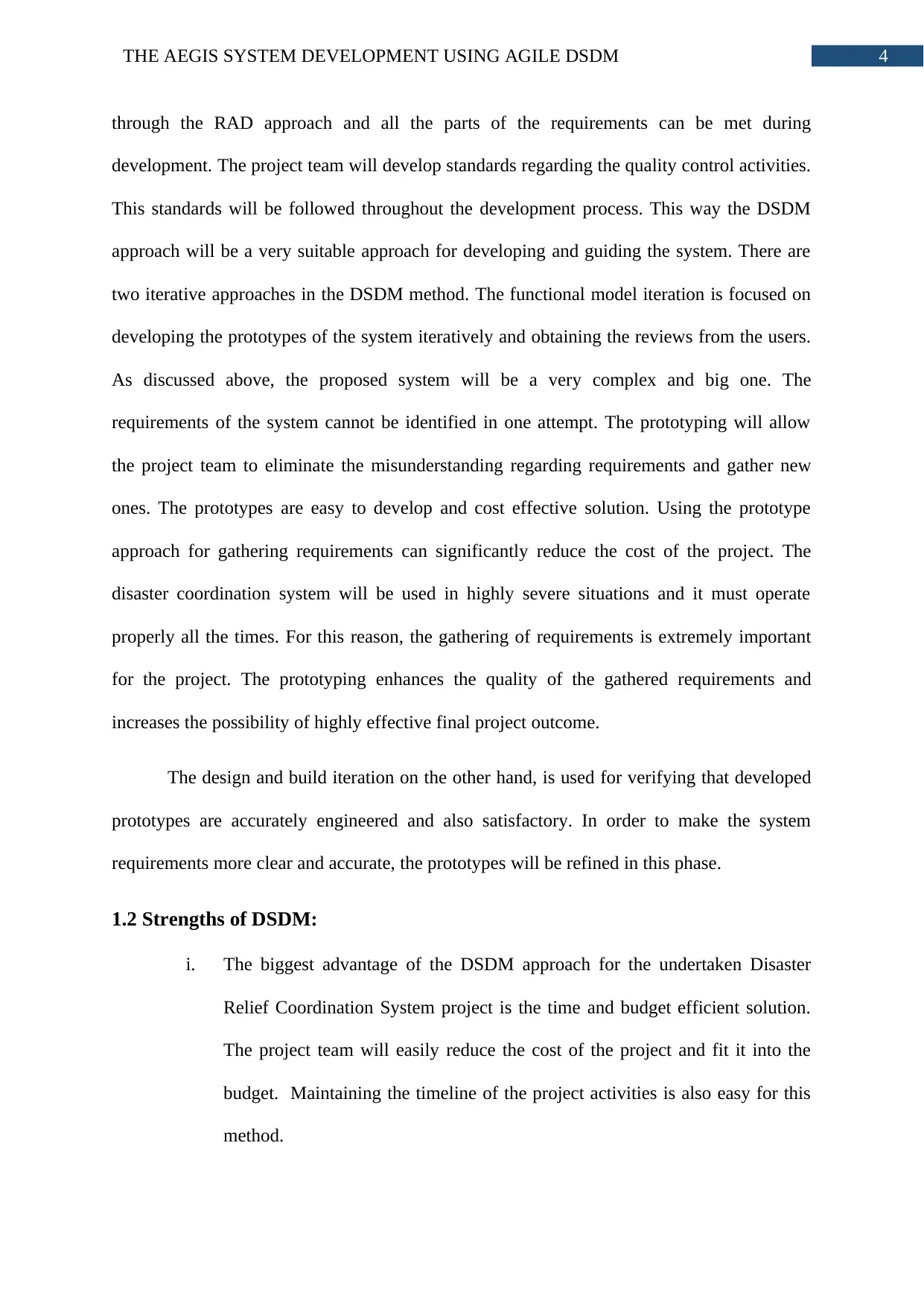
4THE AEGIS SYSTEM DEVELOPMENT USING AGILE DSDM
through the RAD approach and all the parts of the requirements can be met during
development. The project team will develop standards regarding the quality control activities.
This standards will be followed throughout the development process. This way the DSDM
approach will be a very suitable approach for developing and guiding the system. There are
two iterative approaches in the DSDM method. The functional model iteration is focused on
developing the prototypes of the system iteratively and obtaining the reviews from the users.
As discussed above, the proposed system will be a very complex and big one. The
requirements of the system cannot be identified in one attempt. The prototyping will allow
the project team to eliminate the misunderstanding regarding requirements and gather new
ones. The prototypes are easy to develop and cost effective solution. Using the prototype
approach for gathering requirements can significantly reduce the cost of the project. The
disaster coordination system will be used in highly severe situations and it must operate
properly all the times. For this reason, the gathering of requirements is extremely important
for the project. The prototyping enhances the quality of the gathered requirements and
increases the possibility of highly effective final project outcome.
The design and build iteration on the other hand, is used for verifying that developed
prototypes are accurately engineered and also satisfactory. In order to make the system
requirements more clear and accurate, the prototypes will be refined in this phase.
1.2 Strengths of DSDM:
i. The biggest advantage of the DSDM approach for the undertaken Disaster
Relief Coordination System project is the time and budget efficient solution.
The project team will easily reduce the cost of the project and fit it into the
budget. Maintaining the timeline of the project activities is also easy for this
method.
through the RAD approach and all the parts of the requirements can be met during
development. The project team will develop standards regarding the quality control activities.
This standards will be followed throughout the development process. This way the DSDM
approach will be a very suitable approach for developing and guiding the system. There are
two iterative approaches in the DSDM method. The functional model iteration is focused on
developing the prototypes of the system iteratively and obtaining the reviews from the users.
As discussed above, the proposed system will be a very complex and big one. The
requirements of the system cannot be identified in one attempt. The prototyping will allow
the project team to eliminate the misunderstanding regarding requirements and gather new
ones. The prototypes are easy to develop and cost effective solution. Using the prototype
approach for gathering requirements can significantly reduce the cost of the project. The
disaster coordination system will be used in highly severe situations and it must operate
properly all the times. For this reason, the gathering of requirements is extremely important
for the project. The prototyping enhances the quality of the gathered requirements and
increases the possibility of highly effective final project outcome.
The design and build iteration on the other hand, is used for verifying that developed
prototypes are accurately engineered and also satisfactory. In order to make the system
requirements more clear and accurate, the prototypes will be refined in this phase.
1.2 Strengths of DSDM:
i. The biggest advantage of the DSDM approach for the undertaken Disaster
Relief Coordination System project is the time and budget efficient solution.
The project team will easily reduce the cost of the project and fit it into the
budget. Maintaining the timeline of the project activities is also easy for this
method.
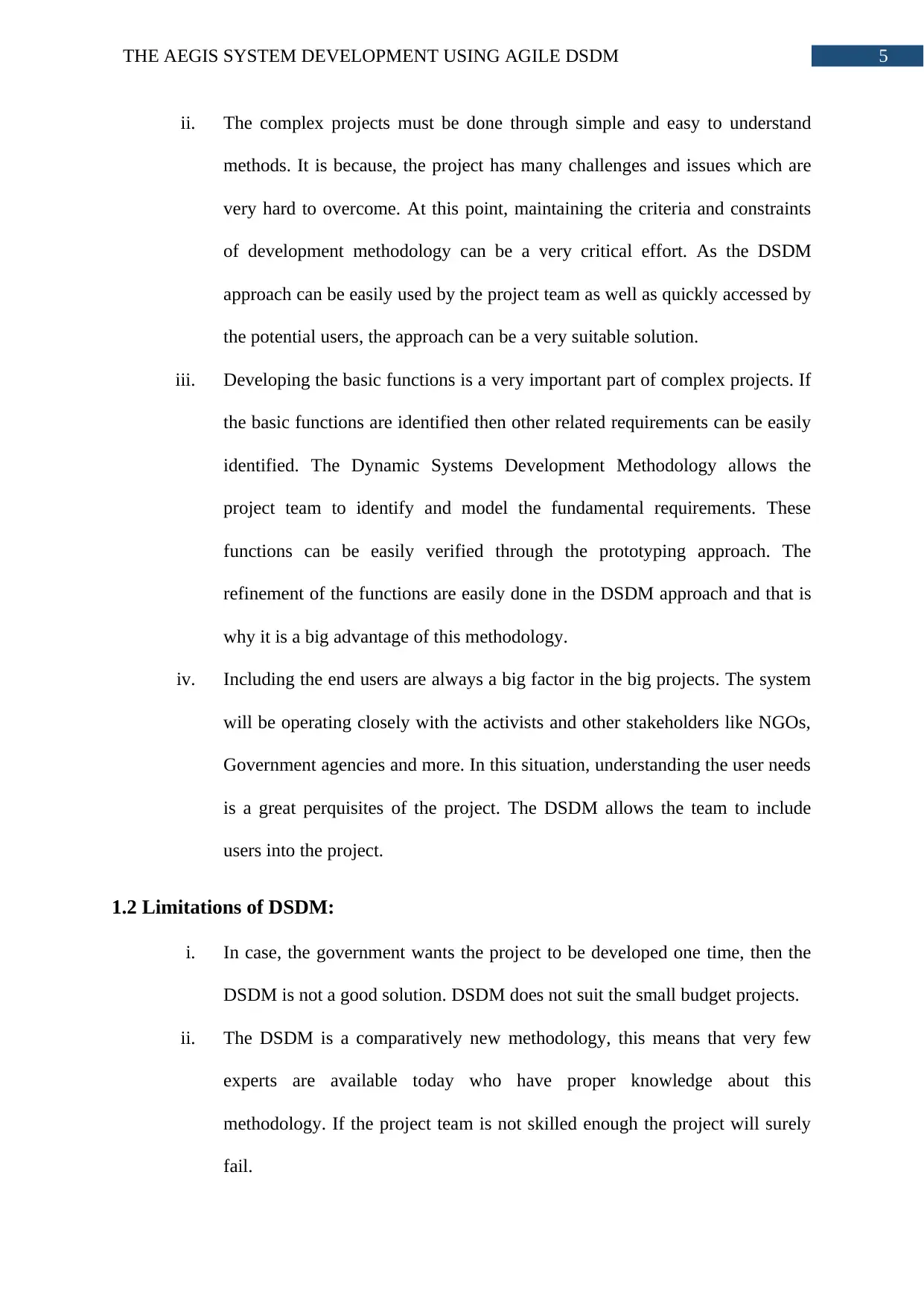
5THE AEGIS SYSTEM DEVELOPMENT USING AGILE DSDM
ii. The complex projects must be done through simple and easy to understand
methods. It is because, the project has many challenges and issues which are
very hard to overcome. At this point, maintaining the criteria and constraints
of development methodology can be a very critical effort. As the DSDM
approach can be easily used by the project team as well as quickly accessed by
the potential users, the approach can be a very suitable solution.
iii. Developing the basic functions is a very important part of complex projects. If
the basic functions are identified then other related requirements can be easily
identified. The Dynamic Systems Development Methodology allows the
project team to identify and model the fundamental requirements. These
functions can be easily verified through the prototyping approach. The
refinement of the functions are easily done in the DSDM approach and that is
why it is a big advantage of this methodology.
iv. Including the end users are always a big factor in the big projects. The system
will be operating closely with the activists and other stakeholders like NGOs,
Government agencies and more. In this situation, understanding the user needs
is a great perquisites of the project. The DSDM allows the team to include
users into the project.
1.2 Limitations of DSDM:
i. In case, the government wants the project to be developed one time, then the
DSDM is not a good solution. DSDM does not suit the small budget projects.
ii. The DSDM is a comparatively new methodology, this means that very few
experts are available today who have proper knowledge about this
methodology. If the project team is not skilled enough the project will surely
fail.
ii. The complex projects must be done through simple and easy to understand
methods. It is because, the project has many challenges and issues which are
very hard to overcome. At this point, maintaining the criteria and constraints
of development methodology can be a very critical effort. As the DSDM
approach can be easily used by the project team as well as quickly accessed by
the potential users, the approach can be a very suitable solution.
iii. Developing the basic functions is a very important part of complex projects. If
the basic functions are identified then other related requirements can be easily
identified. The Dynamic Systems Development Methodology allows the
project team to identify and model the fundamental requirements. These
functions can be easily verified through the prototyping approach. The
refinement of the functions are easily done in the DSDM approach and that is
why it is a big advantage of this methodology.
iv. Including the end users are always a big factor in the big projects. The system
will be operating closely with the activists and other stakeholders like NGOs,
Government agencies and more. In this situation, understanding the user needs
is a great perquisites of the project. The DSDM allows the team to include
users into the project.
1.2 Limitations of DSDM:
i. In case, the government wants the project to be developed one time, then the
DSDM is not a good solution. DSDM does not suit the small budget projects.
ii. The DSDM is a comparatively new methodology, this means that very few
experts are available today who have proper knowledge about this
methodology. If the project team is not skilled enough the project will surely
fail.
⊘ This is a preview!⊘
Do you want full access?
Subscribe today to unlock all pages.

Trusted by 1+ million students worldwide
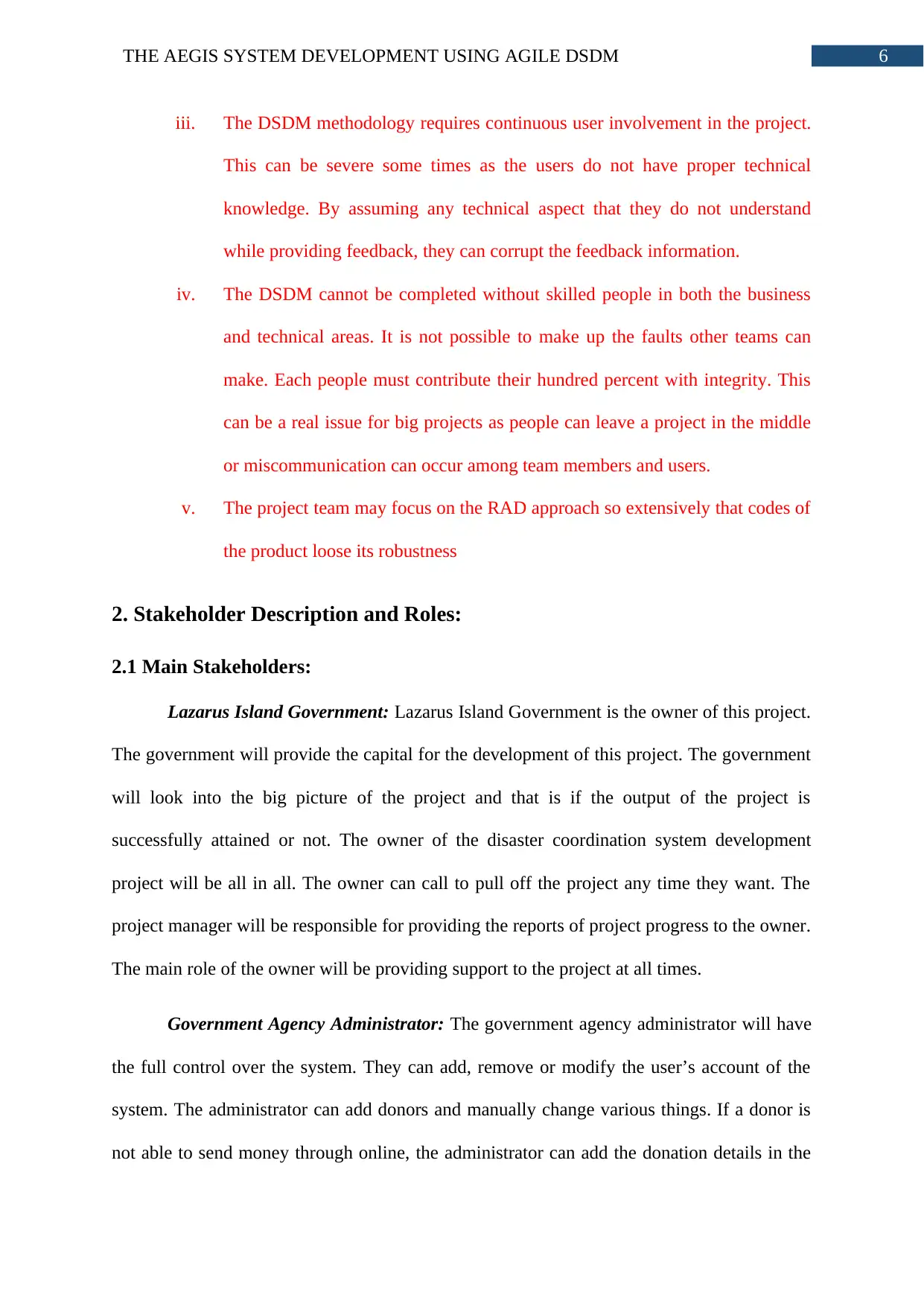
6THE AEGIS SYSTEM DEVELOPMENT USING AGILE DSDM
iii. The DSDM methodology requires continuous user involvement in the project.
This can be severe some times as the users do not have proper technical
knowledge. By assuming any technical aspect that they do not understand
while providing feedback, they can corrupt the feedback information.
iv. The DSDM cannot be completed without skilled people in both the business
and technical areas. It is not possible to make up the faults other teams can
make. Each people must contribute their hundred percent with integrity. This
can be a real issue for big projects as people can leave a project in the middle
or miscommunication can occur among team members and users.
v. The project team may focus on the RAD approach so extensively that codes of
the product loose its robustness
2. Stakeholder Description and Roles:
2.1 Main Stakeholders:
Lazarus Island Government: Lazarus Island Government is the owner of this project.
The government will provide the capital for the development of this project. The government
will look into the big picture of the project and that is if the output of the project is
successfully attained or not. The owner of the disaster coordination system development
project will be all in all. The owner can call to pull off the project any time they want. The
project manager will be responsible for providing the reports of project progress to the owner.
The main role of the owner will be providing support to the project at all times.
Government Agency Administrator: The government agency administrator will have
the full control over the system. They can add, remove or modify the user’s account of the
system. The administrator can add donors and manually change various things. If a donor is
not able to send money through online, the administrator can add the donation details in the
iii. The DSDM methodology requires continuous user involvement in the project.
This can be severe some times as the users do not have proper technical
knowledge. By assuming any technical aspect that they do not understand
while providing feedback, they can corrupt the feedback information.
iv. The DSDM cannot be completed without skilled people in both the business
and technical areas. It is not possible to make up the faults other teams can
make. Each people must contribute their hundred percent with integrity. This
can be a real issue for big projects as people can leave a project in the middle
or miscommunication can occur among team members and users.
v. The project team may focus on the RAD approach so extensively that codes of
the product loose its robustness
2. Stakeholder Description and Roles:
2.1 Main Stakeholders:
Lazarus Island Government: Lazarus Island Government is the owner of this project.
The government will provide the capital for the development of this project. The government
will look into the big picture of the project and that is if the output of the project is
successfully attained or not. The owner of the disaster coordination system development
project will be all in all. The owner can call to pull off the project any time they want. The
project manager will be responsible for providing the reports of project progress to the owner.
The main role of the owner will be providing support to the project at all times.
Government Agency Administrator: The government agency administrator will have
the full control over the system. They can add, remove or modify the user’s account of the
system. The administrator can add donors and manually change various things. If a donor is
not able to send money through online, the administrator can add the donation details in the
Paraphrase This Document
Need a fresh take? Get an instant paraphrase of this document with our AI Paraphraser
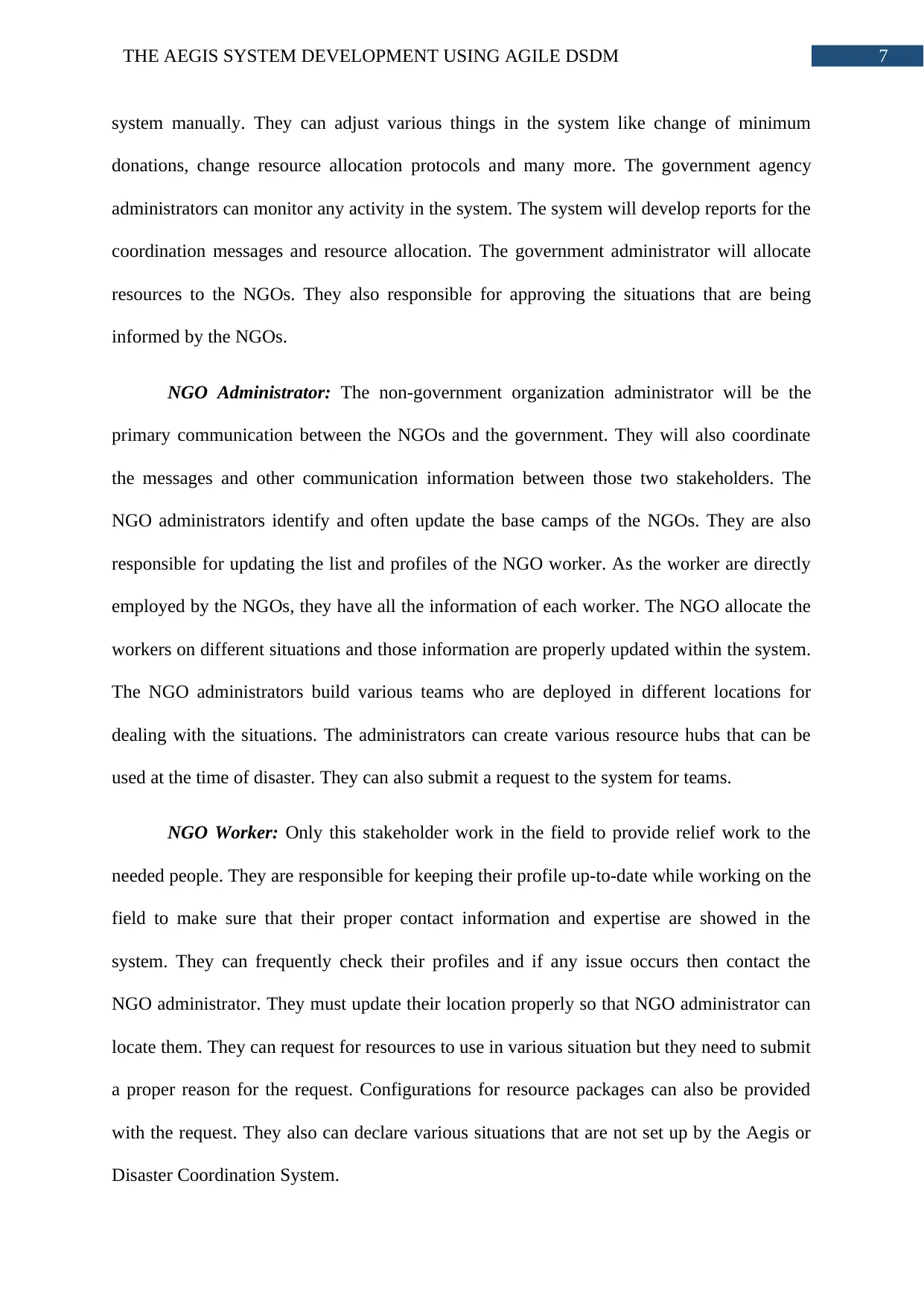
7THE AEGIS SYSTEM DEVELOPMENT USING AGILE DSDM
system manually. They can adjust various things in the system like change of minimum
donations, change resource allocation protocols and many more. The government agency
administrators can monitor any activity in the system. The system will develop reports for the
coordination messages and resource allocation. The government administrator will allocate
resources to the NGOs. They also responsible for approving the situations that are being
informed by the NGOs.
NGO Administrator: The non-government organization administrator will be the
primary communication between the NGOs and the government. They will also coordinate
the messages and other communication information between those two stakeholders. The
NGO administrators identify and often update the base camps of the NGOs. They are also
responsible for updating the list and profiles of the NGO worker. As the worker are directly
employed by the NGOs, they have all the information of each worker. The NGO allocate the
workers on different situations and those information are properly updated within the system.
The NGO administrators build various teams who are deployed in different locations for
dealing with the situations. The administrators can create various resource hubs that can be
used at the time of disaster. They can also submit a request to the system for teams.
NGO Worker: Only this stakeholder work in the field to provide relief work to the
needed people. They are responsible for keeping their profile up-to-date while working on the
field to make sure that their proper contact information and expertise are showed in the
system. They can frequently check their profiles and if any issue occurs then contact the
NGO administrator. They must update their location properly so that NGO administrator can
locate them. They can request for resources to use in various situation but they need to submit
a proper reason for the request. Configurations for resource packages can also be provided
with the request. They also can declare various situations that are not set up by the Aegis or
Disaster Coordination System.
system manually. They can adjust various things in the system like change of minimum
donations, change resource allocation protocols and many more. The government agency
administrators can monitor any activity in the system. The system will develop reports for the
coordination messages and resource allocation. The government administrator will allocate
resources to the NGOs. They also responsible for approving the situations that are being
informed by the NGOs.
NGO Administrator: The non-government organization administrator will be the
primary communication between the NGOs and the government. They will also coordinate
the messages and other communication information between those two stakeholders. The
NGO administrators identify and often update the base camps of the NGOs. They are also
responsible for updating the list and profiles of the NGO worker. As the worker are directly
employed by the NGOs, they have all the information of each worker. The NGO allocate the
workers on different situations and those information are properly updated within the system.
The NGO administrators build various teams who are deployed in different locations for
dealing with the situations. The administrators can create various resource hubs that can be
used at the time of disaster. They can also submit a request to the system for teams.
NGO Worker: Only this stakeholder work in the field to provide relief work to the
needed people. They are responsible for keeping their profile up-to-date while working on the
field to make sure that their proper contact information and expertise are showed in the
system. They can frequently check their profiles and if any issue occurs then contact the
NGO administrator. They must update their location properly so that NGO administrator can
locate them. They can request for resources to use in various situation but they need to submit
a proper reason for the request. Configurations for resource packages can also be provided
with the request. They also can declare various situations that are not set up by the Aegis or
Disaster Coordination System.
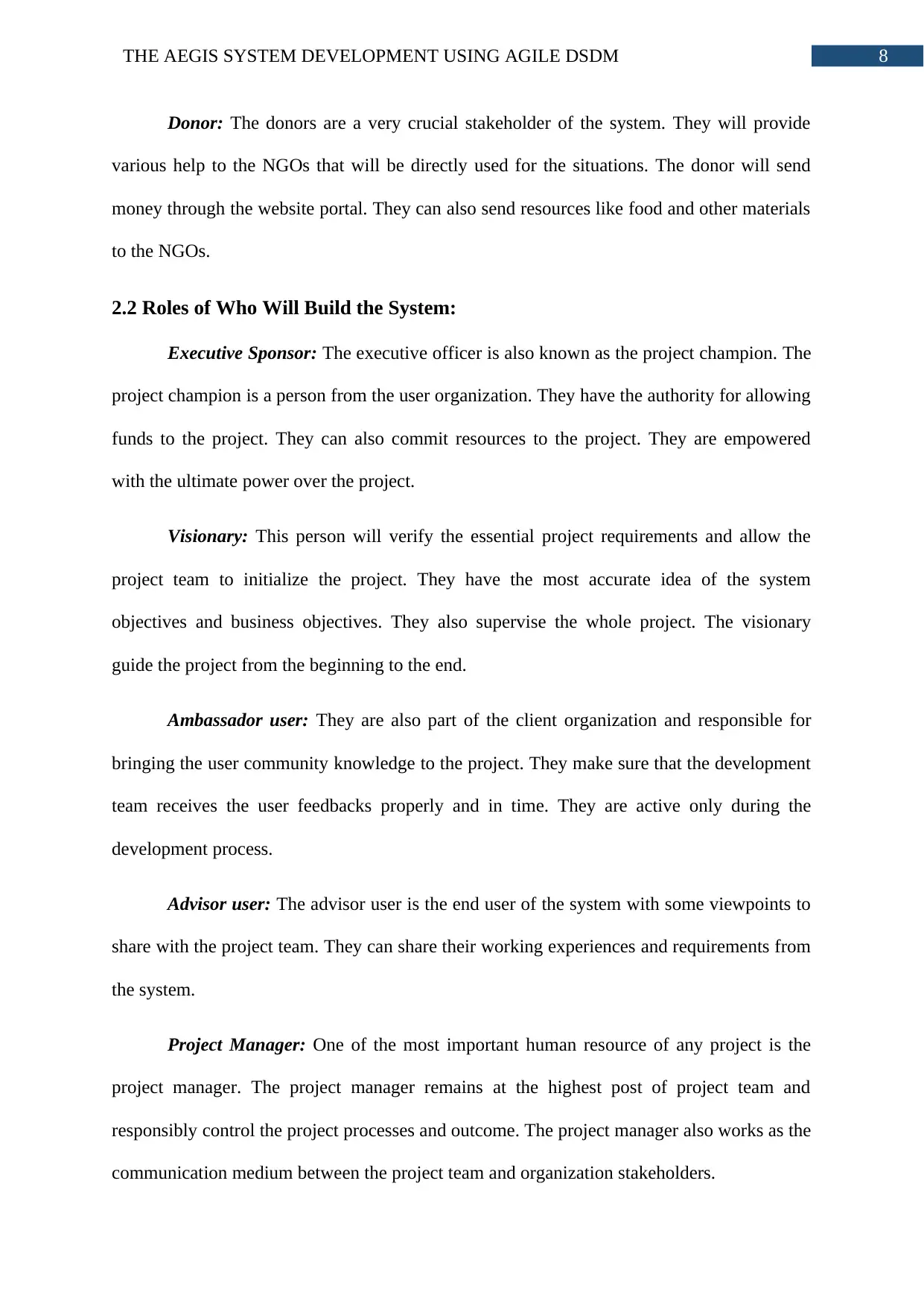
8THE AEGIS SYSTEM DEVELOPMENT USING AGILE DSDM
Donor: The donors are a very crucial stakeholder of the system. They will provide
various help to the NGOs that will be directly used for the situations. The donor will send
money through the website portal. They can also send resources like food and other materials
to the NGOs.
2.2 Roles of Who Will Build the System:
Executive Sponsor: The executive officer is also known as the project champion. The
project champion is a person from the user organization. They have the authority for allowing
funds to the project. They can also commit resources to the project. They are empowered
with the ultimate power over the project.
Visionary: This person will verify the essential project requirements and allow the
project team to initialize the project. They have the most accurate idea of the system
objectives and business objectives. They also supervise the whole project. The visionary
guide the project from the beginning to the end.
Ambassador user: They are also part of the client organization and responsible for
bringing the user community knowledge to the project. They make sure that the development
team receives the user feedbacks properly and in time. They are active only during the
development process.
Advisor user: The advisor user is the end user of the system with some viewpoints to
share with the project team. They can share their working experiences and requirements from
the system.
Project Manager: One of the most important human resource of any project is the
project manager. The project manager remains at the highest post of project team and
responsibly control the project processes and outcome. The project manager also works as the
communication medium between the project team and organization stakeholders.
Donor: The donors are a very crucial stakeholder of the system. They will provide
various help to the NGOs that will be directly used for the situations. The donor will send
money through the website portal. They can also send resources like food and other materials
to the NGOs.
2.2 Roles of Who Will Build the System:
Executive Sponsor: The executive officer is also known as the project champion. The
project champion is a person from the user organization. They have the authority for allowing
funds to the project. They can also commit resources to the project. They are empowered
with the ultimate power over the project.
Visionary: This person will verify the essential project requirements and allow the
project team to initialize the project. They have the most accurate idea of the system
objectives and business objectives. They also supervise the whole project. The visionary
guide the project from the beginning to the end.
Ambassador user: They are also part of the client organization and responsible for
bringing the user community knowledge to the project. They make sure that the development
team receives the user feedbacks properly and in time. They are active only during the
development process.
Advisor user: The advisor user is the end user of the system with some viewpoints to
share with the project team. They can share their working experiences and requirements from
the system.
Project Manager: One of the most important human resource of any project is the
project manager. The project manager remains at the highest post of project team and
responsibly control the project processes and outcome. The project manager also works as the
communication medium between the project team and organization stakeholders.
⊘ This is a preview!⊘
Do you want full access?
Subscribe today to unlock all pages.

Trusted by 1+ million students worldwide
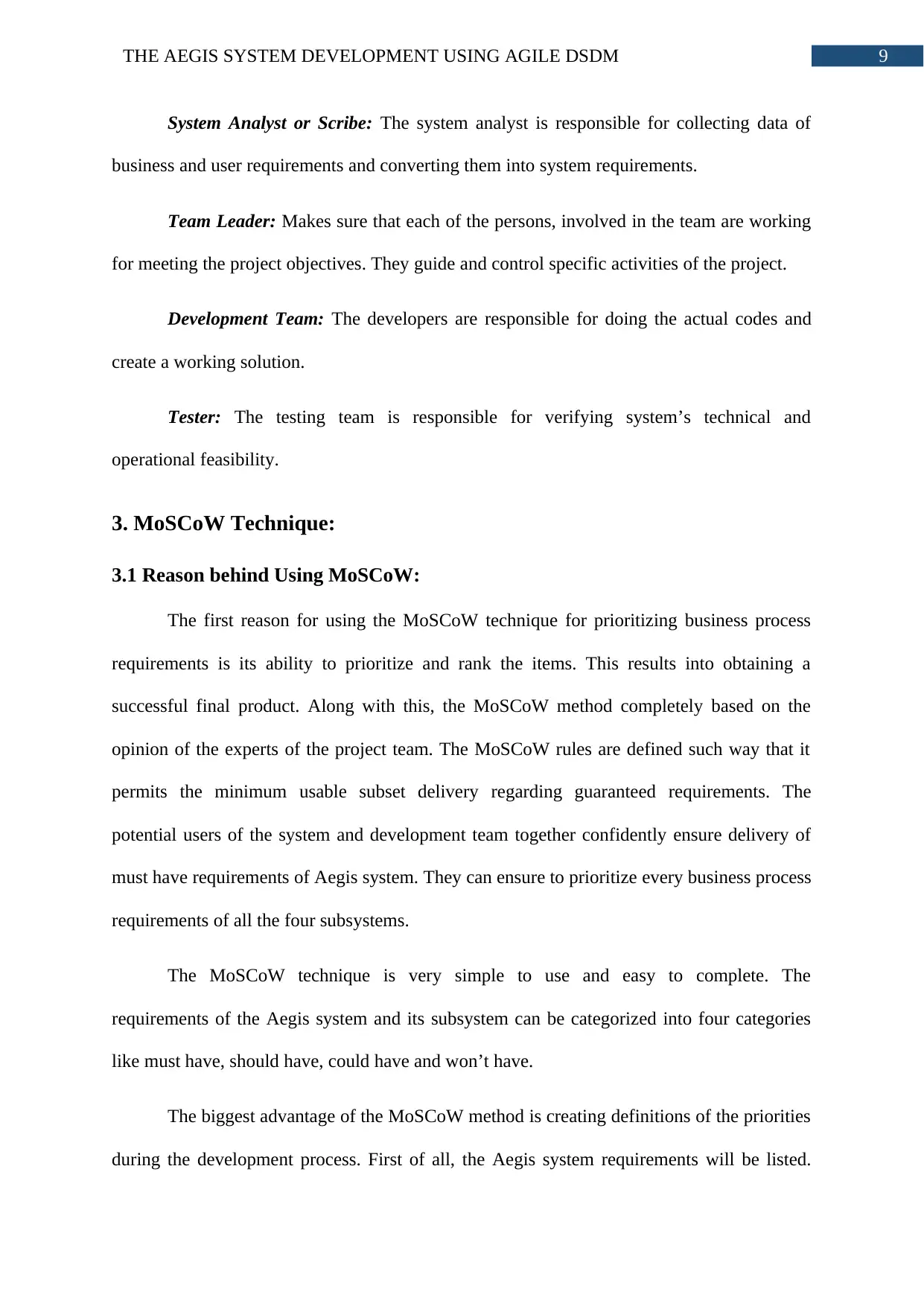
9THE AEGIS SYSTEM DEVELOPMENT USING AGILE DSDM
System Analyst or Scribe: The system analyst is responsible for collecting data of
business and user requirements and converting them into system requirements.
Team Leader: Makes sure that each of the persons, involved in the team are working
for meeting the project objectives. They guide and control specific activities of the project.
Development Team: The developers are responsible for doing the actual codes and
create a working solution.
Tester: The testing team is responsible for verifying system’s technical and
operational feasibility.
3. MoSCoW Technique:
3.1 Reason behind Using MoSCoW:
The first reason for using the MoSCoW technique for prioritizing business process
requirements is its ability to prioritize and rank the items. This results into obtaining a
successful final product. Along with this, the MoSCoW method completely based on the
opinion of the experts of the project team. The MoSCoW rules are defined such way that it
permits the minimum usable subset delivery regarding guaranteed requirements. The
potential users of the system and development team together confidently ensure delivery of
must have requirements of Aegis system. They can ensure to prioritize every business process
requirements of all the four subsystems.
The MoSCoW technique is very simple to use and easy to complete. The
requirements of the Aegis system and its subsystem can be categorized into four categories
like must have, should have, could have and won’t have.
The biggest advantage of the MoSCoW method is creating definitions of the priorities
during the development process. First of all, the Aegis system requirements will be listed.
System Analyst or Scribe: The system analyst is responsible for collecting data of
business and user requirements and converting them into system requirements.
Team Leader: Makes sure that each of the persons, involved in the team are working
for meeting the project objectives. They guide and control specific activities of the project.
Development Team: The developers are responsible for doing the actual codes and
create a working solution.
Tester: The testing team is responsible for verifying system’s technical and
operational feasibility.
3. MoSCoW Technique:
3.1 Reason behind Using MoSCoW:
The first reason for using the MoSCoW technique for prioritizing business process
requirements is its ability to prioritize and rank the items. This results into obtaining a
successful final product. Along with this, the MoSCoW method completely based on the
opinion of the experts of the project team. The MoSCoW rules are defined such way that it
permits the minimum usable subset delivery regarding guaranteed requirements. The
potential users of the system and development team together confidently ensure delivery of
must have requirements of Aegis system. They can ensure to prioritize every business process
requirements of all the four subsystems.
The MoSCoW technique is very simple to use and easy to complete. The
requirements of the Aegis system and its subsystem can be categorized into four categories
like must have, should have, could have and won’t have.
The biggest advantage of the MoSCoW method is creating definitions of the priorities
during the development process. First of all, the Aegis system requirements will be listed.
Paraphrase This Document
Need a fresh take? Get an instant paraphrase of this document with our AI Paraphraser
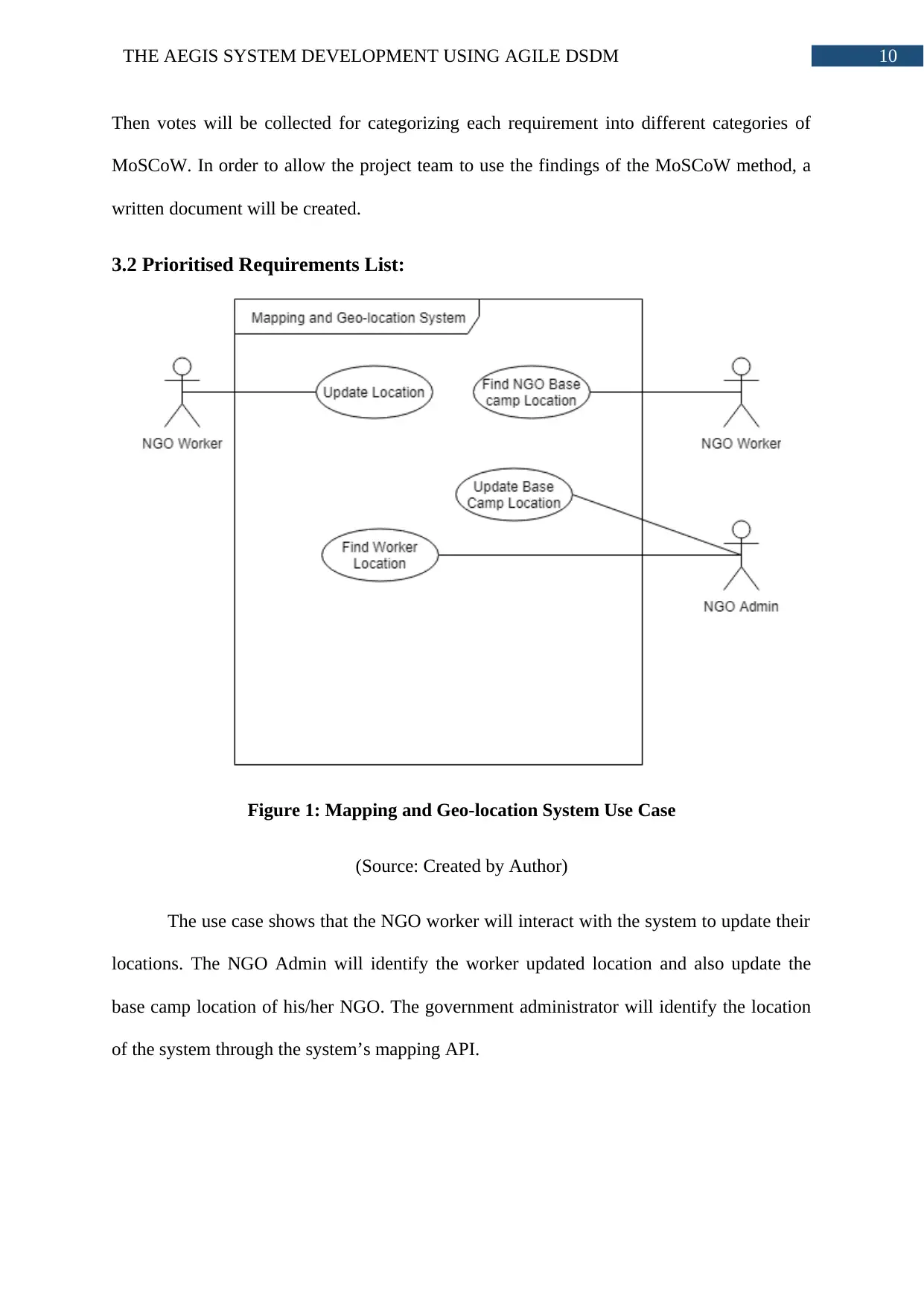
10THE AEGIS SYSTEM DEVELOPMENT USING AGILE DSDM
Then votes will be collected for categorizing each requirement into different categories of
MoSCoW. In order to allow the project team to use the findings of the MoSCoW method, a
written document will be created.
3.2 Prioritised Requirements List:
Figure 1: Mapping and Geo-location System Use Case
(Source: Created by Author)
The use case shows that the NGO worker will interact with the system to update their
locations. The NGO Admin will identify the worker updated location and also update the
base camp location of his/her NGO. The government administrator will identify the location
of the system through the system’s mapping API.
Then votes will be collected for categorizing each requirement into different categories of
MoSCoW. In order to allow the project team to use the findings of the MoSCoW method, a
written document will be created.
3.2 Prioritised Requirements List:
Figure 1: Mapping and Geo-location System Use Case
(Source: Created by Author)
The use case shows that the NGO worker will interact with the system to update their
locations. The NGO Admin will identify the worker updated location and also update the
base camp location of his/her NGO. The government administrator will identify the location
of the system through the system’s mapping API.
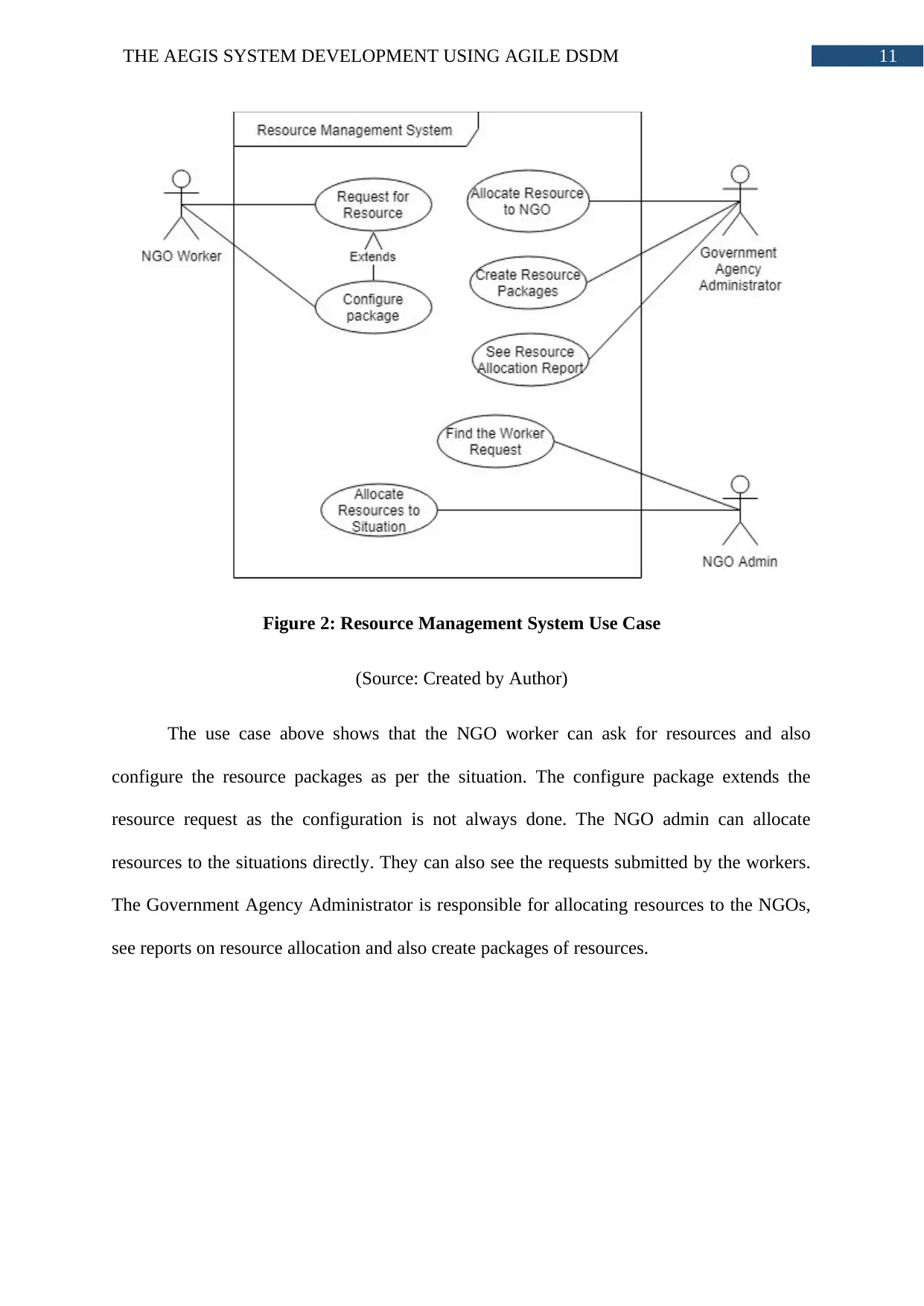
11THE AEGIS SYSTEM DEVELOPMENT USING AGILE DSDM
Figure 2: Resource Management System Use Case
(Source: Created by Author)
The use case above shows that the NGO worker can ask for resources and also
configure the resource packages as per the situation. The configure package extends the
resource request as the configuration is not always done. The NGO admin can allocate
resources to the situations directly. They can also see the requests submitted by the workers.
The Government Agency Administrator is responsible for allocating resources to the NGOs,
see reports on resource allocation and also create packages of resources.
Figure 2: Resource Management System Use Case
(Source: Created by Author)
The use case above shows that the NGO worker can ask for resources and also
configure the resource packages as per the situation. The configure package extends the
resource request as the configuration is not always done. The NGO admin can allocate
resources to the situations directly. They can also see the requests submitted by the workers.
The Government Agency Administrator is responsible for allocating resources to the NGOs,
see reports on resource allocation and also create packages of resources.
⊘ This is a preview!⊘
Do you want full access?
Subscribe today to unlock all pages.

Trusted by 1+ million students worldwide
1 out of 30
Related Documents
Your All-in-One AI-Powered Toolkit for Academic Success.
+13062052269
info@desklib.com
Available 24*7 on WhatsApp / Email
![[object Object]](/_next/static/media/star-bottom.7253800d.svg)
Unlock your academic potential
Copyright © 2020–2025 A2Z Services. All Rights Reserved. Developed and managed by ZUCOL.





